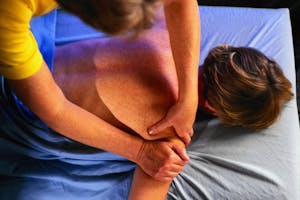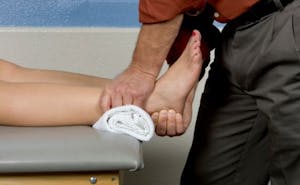
Manual therapy is a hands-on treatment by clinicians to treat muscle aches, joint pain, and limited range of motion. It encompasses a variety of techniques including soft tissue mobilization of muscles, specific joint mobilization, and joint manipulation.
The three most notable forms of manual therapy are:
- Manipulation - the application of a rapid force into a joint(s) often associated with an audible popping sound called cavitation.
- Mobilization - a slower, more controlled process of articular and soft-tissue stretching intended to improve joint mobility.
- Massage - typically the repetitive rubbing, stripping or kneading of muscle and fascia tissues to facilitate healing.
What's the difference between manual therapy and physical therapy?
Most people don't realize there is a difference because the terms manual therapy and physical therapy are used interchangeably. Physical therapy is a superset term used to describe a wide range of treatments, including manual therapy. Some physical therapy treatment techniques are hands-on, others are not. Manual therapy (also known as manipulative therapy) is a subset term under the physical therapy umbrella that involves the hands-on treatment you may be receiving now or are about to receive.
A few examples of manual therapy treatment techniques include:
- Myofascial Release(also known as trigger point therapy) - a hands-on technique used to break up and release irritable bundles of soft tissue that can cause pain and limited range of motion.
- Soft Tissue Mobilization - the use of gentle, slow, passive movements or gentle pressure to break up and relax tense, fibrous muscle tissue.
- Strain-counterstrain - designed to relax spastic muscles by holding a specific position, typically for 90 seconds, and then gently pulling away from it to restore mobility and decompress tissue.
- Instrument-assisted soft tissue mobilization (IASTM) - involves the use of ergonomically designed hand-held instruments that physical therapists use to identify and break down soft tissue adhesions, including excessive scar tissue to restore full function. Examples of IASTM techniques include Graston Technique, HawkGrips, Sound Assisted Soft Tissue Mobilization (SASTM) and Fluid Motion Soft Tissue Tools (FMST).
- Joint Mobilization - similar to soft tissue mobilization, joint mobilization involves the use of gentle, slow, passive movements to activate joints for the purpose of restoring motion and reducing pain and muscle spasms.
- Joint Manipulation - stretching and manipulating major joints (including the elbow, knee, pelvis, back and neck) for the purpose of lossening adhesions and freeing the joint to increase mobility and reduce pain.
- Muscle Energy Techniques (METs) - a broad class of manual therapy techniques commonly used by physical therapists and other healthcare practitioners to increase range of motion, muscular hypertonicity (abnormally rigid muscles that hamper movement), and reduce pain.
Manual therapy has been proven to be an important part of an overall conservative treatment plan for a variety of conditions including:
- Adhesive Capsulitis
- Shoulder Impingement
- Shoulder Stiffness/Limited Range of Motion
- Tennis Elbow (Lateral Epicondylitis)
- Golfer's Elbow (Medial Epicondylitis)
- Pinched Nerves
- Limited Joint Range of Motion
- Capsule Tightness
- Postsurgical Stiffness
- Much More
Manual therapy is typically part of a complete treatment plan that is customized for your specific needs. Give us a call to learn how we can incorporate manual therapy into your rehabilitation program.

